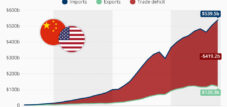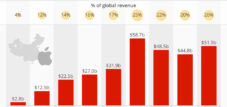Successful China and a stumbling block for Germany? The end of the China miracle and Germany's economic Achilles heel
Language selection 📢
Published on: September 23, 2024 / Update from: September 23, 2024 - Author: Konrad Wolfenstein

From partner to problem zone: China and Germany's fear of the future - The biggest stumbling block for Germany's economy - Image: Xpert.Digital
📈 Unstoppable? China's successful model is beginning to show cracks
🚀 China between success and uncertainty: An economic overview
China's impressive economic rise, which has extended over the past few decades, has long been considered an unshakable model of success. The country has developed from a predominantly agricultural state to the second largest economy in the world. It not only acted as a “workbench in the world”, but also benefited from a number of strategic measures that made China one of the most important actors on the global stage. But this model now shows the first cracks, and the challenges that China faces have far -reaching consequences - not only for the country itself, but also for economic nations like Germany.
📉 🔄 China's rise to become a global economic power
Since the 1980s, China has experienced a historic economic boom. The country opened up to foreign investors, pushed forward reforms and focused on export orientation. China's success rested on several fundamental pillars:
1. Export orientation
China's low-wage sector has been the engine of economic growth for decades. The country positioned itself as a global manufacturing hub by taking advantage of cheap labor and enormous production capacity. International companies relocated their manufacturing processes to China to take advantage of lower costs.
2. Massive investments
China made unprecedented investments in infrastructure projects. Motorways, railway networks, airports and entire cities were built at a rapid pace. These investments enabled China to establish itself as a global hub for trade and manufacturing.
3. The real estate boom
Since the early 2000s, China's real estate market has experienced explosive growth. High-rise buildings, new residential areas and business centers were built in the cities. The real estate sector became one of the main growth drivers of the Chinese economy.
4. Education and qualifications
In parallel with economic reforms, China invested heavily in the education sector. The number of students rose rapidly and the Chinese scientific elite developed into one of the largest in the world. This contributed to China developing increasingly innovative technologies and no longer just functioning as a production location for simple goods.
These pillars of success led to China becoming a global economic power at an impressive pace. But in recent years there have been increasing signs that this model is reaching its limits.
💥 The limits of the Chinese growth model
China's current growth model is coming under increasing pressure. Various structural and external factors play a role:
1. Oversaturation of infrastructure investments
While massive investments in infrastructure development have yielded high returns for decades, the point has been reached where further projects provide less benefit. The country already has an ultra-modern and dense transport network, and new large-scale projects hardly promise any economic added value.
Suitable for:
- Shrinking treatment as a reflection of the global solar industry – thousands of jobs cut in China
- Between overproduction and innovation
2. Housing crisis
The real estate market, which has long served as one of the main engines of the Chinese economy, is in danger of collapsing. The prices for real estate in major cities are sometimes so high that many Chinese can no longer afford apartments. At the same time, there is an overproduction of living space in many regions. This leads to a dangerous bubble, the bursting of which would have far-reaching consequences for the entire economy.
Suitable for:
3. Demographic change
China's population is aging rapidly and labor force growth is stagnating. After decades of a one-child policy, China now faces the problem of not having enough young people to support its aging population. This demographic development is slowing down growth and presenting the pension and healthcare system with immense challenges.
4. Debt at the local level
Many Chinese provincial governments have borrowed heavily to finance extensive infrastructure projects. This debt burden could become a serious financial burden if the economy continues to stagnate.
5. International tensions
The trade conflict with the USA and increasing geopolitical tensions are weighing on China's export economy. The pressure on China to become less dependent on foreign markets is growing.
📊 Necessary transformation of the Chinese economy
Given these challenges, it is clear that China must fundamentally transform its current economic model in order to remain successful in the long term. The key areas for this transformation are:
1. Strengthening domestic consumption
While China's economy was previously heavily dependent on exports, domestic consumption is now expected to play a larger role. A greater focus on the purchasing power of our own population could help reduce dependence on global markets.
2. Promote innovation and technology
China strives to break away from the role of the “workbench of the world” and climb into the global innovation leader. The state is massively investing in research and development, especially in the areas of artificial intelligence, renewable energies and electromobility.
3. Sustainability and environmental protection
China's growing environmental awareness is forcing the country to reduce its ecological footprint. Reducing emissions and transitioning to a more sustainable economy are increasingly seen as important priorities.
4. Expansion of the service sector
A stronger focus on the service sector could provide new growth impulses. This includes not only the expansion of financial services, but also areas such as health, education and tourism.
⚔️ Implementation challenges
However, implementing this economic transformation will not be easy. There are several hurdles that must be overcome:
1. Political control
The Chinese government wants to promote economic modernization, but at the same time does not want to give up political control. This leads to tensions, particularly with regard to the liberalization of markets and dealing with international investors.
2. Reform of state-owned enterprises
Many Chinese state-owned enterprises are inefficient and a drain on the economy. Comprehensive reform of these enterprises is necessary but politically sensitive because many of these enterprises have close ties to the Communist Party.
3. Social inequality
Despite economic growth, inequality has increased in China. The gap between rich and poor is wide open and the government is faced with the challenge of maintaining social peace.
4. Reorganization of international relations
China's role in the global economy is changing. The country must find a balance between its economic power and the political tensions caused by its increasing dominance on the international stage.
📉 Impact on Germany
China's economic development has a direct impact on the German economy. Germany, as one of the largest export nations in the world, is closely linked to the Chinese economy. The challenges in China particularly affect key German industries:
1. Automotive industry
German car manufacturers have benefited from the booming Chinese market for years. But in the area of electromobility, Chinese manufacturers now have a technological lead that is causing headaches for German companies.
2. Mechanical engineering
China's declining investment in infrastructure expansion is having a direct impact on German mechanical engineering, which relies heavily on exports to China.
3. Chemical industry
The German chemical industry is also feeling the effects of the slowdown in the Chinese economy, as many of its products are exported to China.
4. Dependence on China
The German economy has developed a strong dependence on China in recent decades. This dependency is increasingly being questioned critically, and many companies are looking for alternatives.
🚀 Necessary adjustments in Germany
In order to respond to the challenges in China, the German economy must also reposition itself. Important steps here are:
1. Diversification of markets
German companies must reduce their dependence on China and open up new sales markets, especially in Southeast Asia and Africa.
2. Strength in innovation
In order to survive in global competition, German companies must further expand their innovative strength and invest in research and development.
3. Structural change in the automotive industry
The automotive industry in particular is facing a profound change towards electromobility. German manufacturers must actively shape this change in order to remain competitive.
🏁 Economic change is a crucial turning point
The economic transformation in China marks a decisive turning point that extends far beyond the country's borders. For Germany, as a close trading partner, the challenges are great. But at the same time, this change also offers opportunities. Both China and Germany must reinvent themselves in order to secure long-term economic success and prosperity for their citizens.
📣 Similar topics
- 🇨🇳 China's path to becoming a global economic power
- 🚀 The rise and challenges of China
- 🌐 China's economic transformation
- 🔧 The change in the Chinese economic model
- 🏢 China's infrastructure and its borders
- 🏘️ Real estate crisis and its consequences
- 👴 Demographic change and its effects
- 💼 International tensions and trade
- 🔬 Innovation and technology focus in China
- 🌱 Sustainability and environmental protection in China's economy
#️⃣ Hashtags: #ChinaEconomy #Germany #Globalization #Innovation #Transformation
We are there for you - advice - planning - implementation - project management
☑️ Industry expert, here with his own Xpert.Digital industry hub with over 2,500 specialist articles
I would be happy to serve as your personal advisor.
You can contact me by filling out the contact form below or simply call me on +49 89 89 674 804 (Munich) .
I'm looking forward to our joint project.
Xpert.Digital - Konrad Wolfenstein
Xpert.Digital is a hub for industry with a focus on digitalization, mechanical engineering, logistics/intralogistics and photovoltaics.
With our 360° business development solution, we support well-known companies from new business to after sales.
Market intelligence, smarketing, marketing automation, content development, PR, mail campaigns, personalized social media and lead nurturing are part of our digital tools.
You can find out more at: www.xpert.digital - www.xpert.solar - www.xpert.plus























